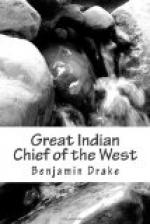There are but three kinds of musical instruments used among these tribes. The drum, which is beat at their feasts, dances and games, the tambourin, and a kind of flageolet, made of cane or two pieces of soft wood hollowed out and fastened together with strips of leather. Their tunes are always on a flat key, have but few variations and are mostly of a melancholy character. According to Mr. Atwater, who visited those residing near Rock Island, in 1829, the Sacs and Foxes have “tunes evidently of French origin, and some songs of considerable length.” “These Indians have among them, what answers to the Italian Improvisatori who make songs for particular occasions.” The same writer says, “the Sauks and Foxes have a considerable number of songs, suited to a great many occasions in their own language.” He further adds, “Among the Indians of the Upper Mississippi, the Sauks and Foxes are decidedly the best actors, and have the greatest variety of plays among them.” In common with the Indian tribes generally, they have a variety of athletic games, in which both the men and women join. They are addicted to cards and other games of chance, and often bet very high.
Touching the condition of these tribes in 1805, Lieutenant Pike, in his travels to the sources of the Mississippi, says, “The first nation of Indians whom we met with, were the Sauks, who principally reside in four villages. The first at the head of the rapids des Moyens, on the west shore, containing thirteen lodges. The second on a prairie on the east shore about sixty miles above. The third on the river De Roche [Rock river] about three miles from the entrance, and the last on the river Iowa. They hunt on the Mississippi and its confluent streams from the Illinois to the river Des Iowa; and on the plains west of them which border the Mississippi. They are so perfectly consolidated with the Reynards (the Foxes) that they can scarcely be termed a distinct nation; but recently there appears to be a schism between the two nations: the latter not approving of the insolence and ill-will, which has marked the conduct of the former towards the United States, on many late occurrences. They have for many years past made war (under the auspices of the Sioux) on the Santeaux, Osages and Missouries; but as recently a peace has been (through the influence of the United States) made between them and the nations of the Missouri, and by the same means between the Sioux and the Santeaux (their principal allies) it appears it would be by no means a difficult matter to induce them to make a general peace, and pay still greater attention to the cultivation of the earth: as they now raise a considerable quantity of corn, beans and melons. The character which they bear with their savage brethren, is, that they are much more to be dreaded for their deceit and inclination for stratagem, than for open courage.




